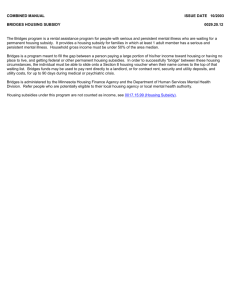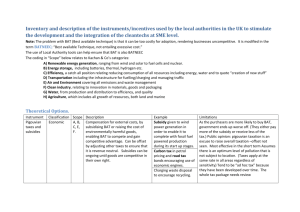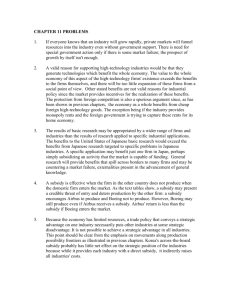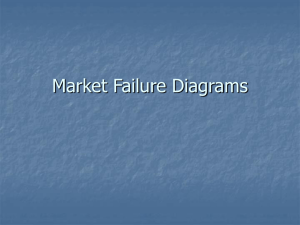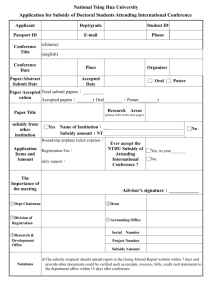How can we solve market failure tax - Business-TES
advertisement
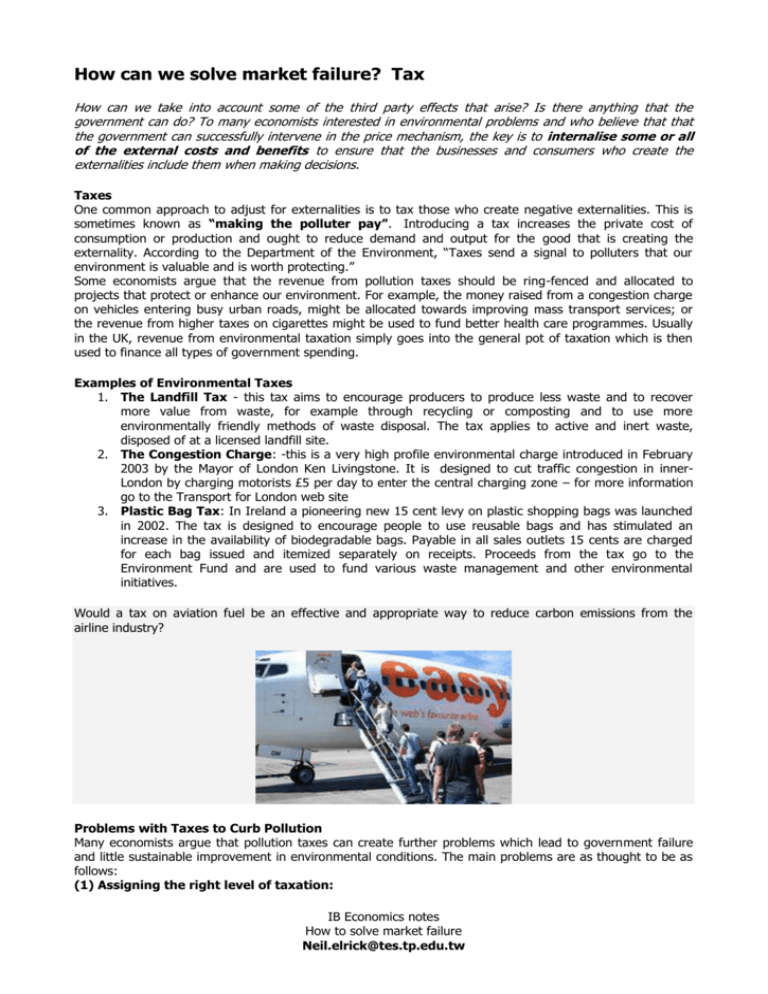
How can we solve market failure? Tax How can we take into account some of the third party effects that arise? Is there anything that the government can do? To many economists interested in environmental problems and who believe that that the government can successfully intervene in the price mechanism, the key is to internalise some or all of the external costs and benefits to ensure that the businesses and consumers who create the externalities include them when making decisions. Taxes One common approach to adjust for externalities is to tax those who create negative externalities. This is sometimes known as “making the polluter pay”. Introducing a tax increases the private cost of consumption or production and ought to reduce demand and output for the good that is creating the externality. According to the Department of the Environment, “Taxes send a signal to polluters that our environment is valuable and is worth protecting.” Some economists argue that the revenue from pollution taxes should be ring-fenced and allocated to projects that protect or enhance our environment. For example, the money raised from a congestion charge on vehicles entering busy urban roads, might be allocated towards improving mass transport services; or the revenue from higher taxes on cigarettes might be used to fund better health care programmes. Usually in the UK, revenue from environmental taxation simply goes into the general pot of taxation which is then used to finance all types of government spending. Examples of Environmental Taxes 1. The Landfill Tax - this tax aims to encourage producers to produce less waste and to recover more value from waste, for example through recycling or composting and to use more environmentally friendly methods of waste disposal. The tax applies to active and inert waste, disposed of at a licensed landfill site. 2. The Congestion Charge: -this is a very high profile environmental charge introduced in February 2003 by the Mayor of London Ken Livingstone. It is designed to cut traffic congestion in innerLondon by charging motorists £5 per day to enter the central charging zone – for more information go to the Transport for London web site 3. Plastic Bag Tax: In Ireland a pioneering new 15 cent levy on plastic shopping bags was launched in 2002. The tax is designed to encourage people to use reusable bags and has stimulated an increase in the availability of biodegradable bags. Payable in all sales outlets 15 cents are charged for each bag issued and itemized separately on receipts. Proceeds from the tax go to the Environment Fund and are used to fund various waste management and other environmental initiatives. Would a tax on aviation fuel be an effective and appropriate way to reduce carbon emissions from the airline industry? Problems with Taxes to Curb Pollution Many economists argue that pollution taxes can create further problems which lead to government failure and little sustainable improvement in environmental conditions. The main problems are as thought to be as follows: (1) Assigning the right level of taxation: IB Economics notes How to solve market failure Neil.elrick@tes.tp.edu.tw There are problems in setting tax so that private cost will exactly equate with the social cost. The government cannot accurately value the private benefits and cost of firms let alone put a monetary value on externalities such as the cost to natural habitat, the long-term effects if resource depletion and the value of human life (2) Imperfect information: Without accurate information setting the tax at the correct level is impossible. In reality, therefore, all that governments and regulatory agencies can hope to achieve is a movement towards the optimum level of output. (3) Consumer welfare effects 1. Taxes reduce output and raise prices, and this might have an adverse effect on consumer welfare. Producers may be able to pass on the tax to the consumers if the demand for the good is inelastic and, as result, the tax may only have a small effect in reducing demand 2. Taxes on some de-merit goods (for example cigarettes) may have a regressive effect on lowerincome consumers and leader to a widening of inequalities in the distribution of income. (4) Employment and investment consequences: If pollution taxes are raised in one country, producers may shift production to countries with lower taxes. This will not reduce global pollution, and may create problems such as structural unemployment and a loss of international competitiveness. Similarly higher taxation might lead to a decline in profits and a fall in the volume of investment projects that in the long term might have beneficial spill-over effects in reducing the energy intensity of an industry or might lead to innovation which enhance the environment. Dumped rubbish on the streets of the UK – the landfill tax is widely regarded as having encouraged flytipping Indirect taxation What are indirect taxes? An indirect tax is imposed on producers (suppliers) by the government. Examples include excise duties on cigarettes, alcohol and fuel and also value added tax. Taxes are levied by the government for a number of reasons – among them as part of a strategy to curb pollution and improve the environment. A tax increases the costs of a business causing an inward shift in the supply curve. The vertical distance between the pre-tax and the post-tax supply curve shows the tax per unit. With an indirect tax, the supplier may be able to pass on some or all of this tax onto the consumer through a higher price. This is known as shifting the burden of the tax and the ability of businesses to do this depends on the price elasticity of demand and supply. IB Economics notes How to solve market failure Neil.elrick@tes.tp.edu.tw In the left hand diagram, demand is elastic meaning that demand is responsive to a change in price. The producer must absorb most of the tax itself (i.e. accept a lower profit margin on each unit sold). When demand is elastic, the effect of a tax is to raise the price – but we see a bigger fall in equilibrium quantity. Output has fallen from Q to Q1 due to a contraction in demand. In the right hand diagram above demand for the product is inelastic and therefore the producer is able to pass on most of the tax to the consumer through a higher price without losing too much in the way of sales. IB Economics notes How to solve market failure Neil.elrick@tes.tp.edu.tw Who pays the tax? The burden of taxation Taxation, elasticity of demand and government revenue The Government would rather place indirect taxes on commodities where demand is inelastic because the tax causes only a small fall in the quantity consumed and as a result the total revenue from taxes will be greater. An example of this is the high level of duty on cigarettes and petrol. The table below shows the demand and supply schedules for a good Price (£) Quantity Demanded 10 9 8 7 6 5 4 20 60 150 260 400 600 900 1 Quantity (Pre-tax) 1280 1000 850 600 400 150 50 What is the initial equilibrium price and quantity? IB Economics notes How to solve market failure Neil.elrick@tes.tp.edu.tw Supplied Quantity (Post-tax) 600 400 150 50 Price = Quantity = 400 supplied £6 2 3 4 5 The government imposes a tax of £3 per unit. The new supply schedule is shown in the right hand column of the table – less is now supplied at each and every market price Find the new equilibrium price after the tax has been imposed New price =£8 Calculate the total tax revenue going to the government Tax revenue = £450 How have consumers been affected by this tax? There has been a fall in quantity traded and a rise in the price paid by consumers – this leads to a fall in economic welfare as measured by consumer surplus Specific taxes A specific tax is where the tax per unit is a fixed amount – for example the duty on a pint of beer or the tax per packet of twenty cigarettes. Another example is the air passenger duty which imposes a standard tax of £10 for flights within the European Economic Area (EEA) and £40 for flights outside of the EEA Ad valorem taxes Where the tax is a percentage of the cost of supply – the best example of this is value added tax currently levied at the standard rate of 17.5% or Insurance Premium Tax which is taxed at 5%. In the diagram below, an ad valorem tax has been imposed on producers. The market equilibrium price rises from P1 to P2 whilst quantity traded falls from Q1 to Q2. Note that the effect of an ad valorem tax is to cause a pivotal shift in the supply curve. This is because the tax is a percentage of the unit cost of supplying the product. So a good that could be supplied for a cost of £50 will now cost £58.75 when VAT of 17.5% is applied whereas a different good that costs £400 to supply will now cost £470 when the same rate of VAT is applied. The absolute amount of the tax will go up as the market price increases. In recent years the government has encouraged a switch away from direct taxation on income towards indirect taxes on the goods and services that we buy and then consume. A wider range of indirect taxes has been introduced including the Insurance Premium Tax, the Air Passenger Duty and the Landfill Tax. IB Economics notes How to solve market failure Neil.elrick@tes.tp.edu.tw Subsidies While we are talking about taxation, lets look at subsidies. This time the Government pays one produce/consume something, as left to the market, we would under produce/consume. Government Subsidy A subsidy is a payment by the government to suppliers that reduce their costs of production and encourages them to increase output. The effect of a government subsidy is to increase supply and (ceteris paribus) reduce the market equilibrium price. The subsidy causes the firm's supply curve to shift to the right. The amount spent on the subsidy is equal to the subsidy per unit multiplied by total output. Occasionally the government can offer a direct subsidy to the consumer – which has the effect of boosting demand in a market Different Types of Producer Subsidy 1. A guaranteed payment on the factor cost of a product – e.g. a guaranteed minimum price offered to farmers 2. An input subsidy which subsidises the cost of certain inputs used in production – e.g. an employment subsidy for taking on more employees 3. Government grants to cover losses made by a business – e.g. a grant given to cover losses in the railway industry 4. Financial assistance (loans and grants) for businesses setting up in areas of high unemployment – e.g. as part of a regional policy designed to boost employment Showing the effect of a subsidy to producers To what extent will a subsidy feed through to lower prices for consumers? This depends on the price elasticity of demand for the product. The more inelastic the demand curve the greater the consumer's gain from a subsidy. Indeed when demand is perfectly inelastic the consumer gains most of the benefit from the subsidy since all the subsidy is passed onto the consumer through a lower price. When demand is relatively elastic, the main effect of the subsidy is to increase the equilibrium quantity traded rather than lead to a much lower market price. IB Economics notes How to solve market failure Neil.elrick@tes.tp.edu.tw The Economic and Social Justifications for Subsidies Why might the government be justified in providing financial assistance to producers in certain markets and industries? How valid are the arguments for government subsidies? 1. To control the rate of inflation and boost the real living standards of some groups of consumers – for example lower income households. 2. To encourage the provision and consumption of merit goods and services which are said to generate positive externalities (increased social benefits). Under-consumption or provision of merit goods can lead to market failure causing a loss of social welfare 3. Maintain or increase the revenues (incomes) of producers during times of special difficulties in markets (consider some of the examples mentioned below) 4. Reduce the cost of capital investment projects – which might help to stimulate economic growth by increasing long-run aggregate supply 5. Subsidies to smooth or slow-down the process of long term structural change/decline in an industry (for example in farming, coal, fishing and steel) 6. Boost employment for certain groups of workers e.g. the long term unemployed Economic Arguments against Subsidies The economic and social case for a subsidy should be judged carefully on the grounds of economic efficiency and also fairness (or equity). We need to be careful to measure and evaluate who gains from any particular subsidy and who pays. Might the money used up in subsidy payments be better spent elsewhere? Government subsidies inevitably carry an opportunity cost and in the long run there might be better ways of providing financial support to producers and employees in specific industries. Free market economists argue that government subsidies distort the workings of the free market mechanism and can eventually lead to government failure where government intervention actually leads to a worse distribution of resources. 1. Distortion of the Market: Subsidies distort market prices - this can lead to a misallocation of resources – many economists believe that the free-market mechanism works best. Export subsidies distort the free trade in goods and services and can severely curtail the ability of ELDCs to compete in the markets of industrialised countries 2. Arbitrary Assistance: Decisions about which groups or industries receive a subsidy can be arbitrary – if tourism is supported, why not the British steel industry? 3. Financial Cost: Subsidies can become expensive – note the opportunity cost! IB Economics notes How to solve market failure Neil.elrick@tes.tp.edu.tw 4. Who pays and who benefits?: The final cost of a subsidy usually falls on consumers (tax-payers) who themselves may have derived no benefit from the subsidy 5. Encouraging inefficiency: Subsidy can artificially protect inefficient firms who need to restructure – i.e. it delays much needed economic reforms 6. Risk of Fraud: Ever-present risk of fraud when allocating subsidy payments There are alternatives: It may be possible to achieve the objectives of subsidies by alternative means which have less distorting effects, for example by direct income support through the tax and benefit system IB Economics notes How to solve market failure Neil.elrick@tes.tp.edu.tw

